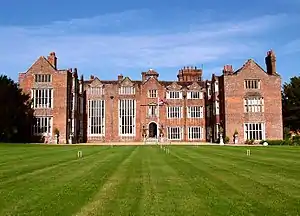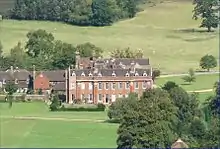Danny House
Danny is a Grade I listed Elizabethan red brick Mansion near Hurstpierpoint in West Sussex, England.[1] It lies at the northern foot of Wolstonbury Hill and may be regarded as one of the finest stately houses in Sussex, with 56 bedrooms and 28 apartments. The present house was built 1593–95 by George Goring, on the site of an older house. It is set in eight acres (32,000 m²) of gardens at the foot of the South Downs within an historic parkland of some 400 acres, which was granted by royal charter in 1333.

History
Pre-Roman
The outline of a Bronze Age enclosure exists above Danny House on the top of nearby Wolstonbury Hill (now owned by the National Trust and within the South Downs National Park). On the west side of Wolstonbury there is a large artificial plateau thought to be the site of an Iron Age camp.
Roman times
The Sussex Greensand Way Roman road passed through the site of Danny Park in an east-west direction, making an alignment change on the hill to the north of the house. The road survives as a terrace on the shoulder of the hill, a hollow way leading down the hill and a raised strip leading to the stream. A Roman pottery kiln has been found south of the road.[2]
Domesday Book
The Domesday Book of 1086 recorded that 'Robert holds Herst of William', i.e. that Robert de Pierpoint held the land from William de Warenne, who was a son-in-law of William the Conqueror.
13th century
There has been a house of some sort on this site since the 13th century, originally little more than a hunting-lodge, when the medieval Park of Danny was enclosed by the last Sir Simon de Pierpoint in 1343
Late 16th century
The house in its present form dates from the early sixteenth century but was reconstructed and enlarged by George Goring in 1593, after he had purchased the estate in 1582. It was designed in the shape of the letter E to represent the Queen (Elizabeth I of England) who had been on the throne for over 30 years at the commencement of the reconstruction work. The house represents a fine example of Elizabethan architecture.
The current house has two main fronts, the east 16th Century, the south early Georgian. The brick-built east frontage is monumental, the south front stately, the whole building a prominent element in views from the downs. It stands to three storeys.

Mid 17th century
After four generations of Gorings, Danny was sold to Peter Courthope in 1650. In 1652 Danny Great Park was 54 ha (135 acres) with arable land and meadow amounting to about 170 ha (420 acres). The parkland still contains large, noble oaks of varying ages and growth patterns and is used today for a variety of recreational activities.
In 1702, Barbara Courthope married Henry Campion, and in 1725 they made Danny their home, and soon undertook extensive alterations, including the re-fronting of the south side of the house as is confirmed by the date 1728 and their initials on the leaden water-pipes. Several generations of Campions followed.
The world’s earliest cricket ground
Cricket is recorded in the Thomas Marchant’s diaries as having been played at Sand Field, Danny Park in 1717. This makes Sand Field the earliest identifiable cricket ground in the world. In July 2017, the tri-centenary of the occasion was celebrated by a match played between Danny House and Hurstpierpoint Cricket Club.
War Cabinet
During World War I, Danny was rented for four months to Prime Minister Lloyd George, where he lived here in a menage a trois with his wife Margaret and his secretary and mistress Frances Stevenson. Regular meetings of the Imperial War Cabinet were held in the Great Hall, where on 13 October 1918 terms of the armistice to be offered to Germany at the end of the Great War were decided, and authority was given to US President Woodrow Wilson to negotiate the Armistice.
There were some letters, written at Danny, from Lloyd George to Frances Stevenson, one of which read:
"My darling Pussy. You might phone from the Treasury on Friday if you can come. Don't let Hankey see you. If Saturday impossible, what about Monday? Fondest love to my own."
D. (Hankey was then Cabinet Secretary).
Recent history
Soon after the war Danny House became a school, firstly known as Montpelier College and then Wolstonbury College, which had been transferred from Brighton, but this closed down in 1956. Although the Campion family were no longer residing in the house, the estate continued in the ownership of the Campions until the 1980s when the estate was broken up and the various land holdings, houses and farms were sold to tenants or into private hands. The house was then bought by Mutual Households Association (later the Country Houses Association). After the CHA went into liquidation in 2003,[3] the house was bought by a private purchaser in 2004. In 2007, Danny House celebrated 50 years as a retirement home.
Bibliography
- Sussex County Magazine Vol. 1, page 457
- Country Life, 22 March 1913
References
- Historic England. "Danny (1285424)". National Heritage List for England. Retrieved 12 November 2014.
- I D Margary, Roman Ways in the Weald Phoenix House, Revised 1965 pp171-2
- http://news.bbc.co.uk/1/hi/england/3319953.stm
External links
| Wikimedia Commons has media related to Danny House. |
